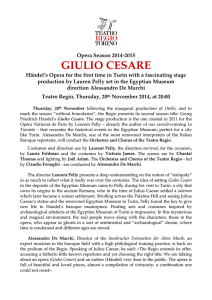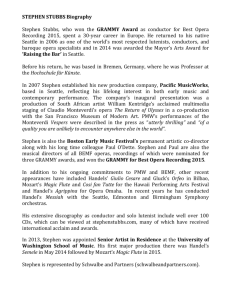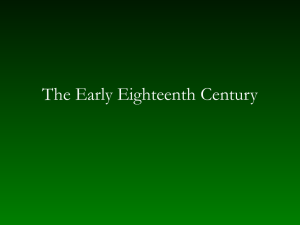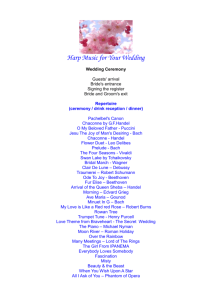Marjo Suominen
advertisement
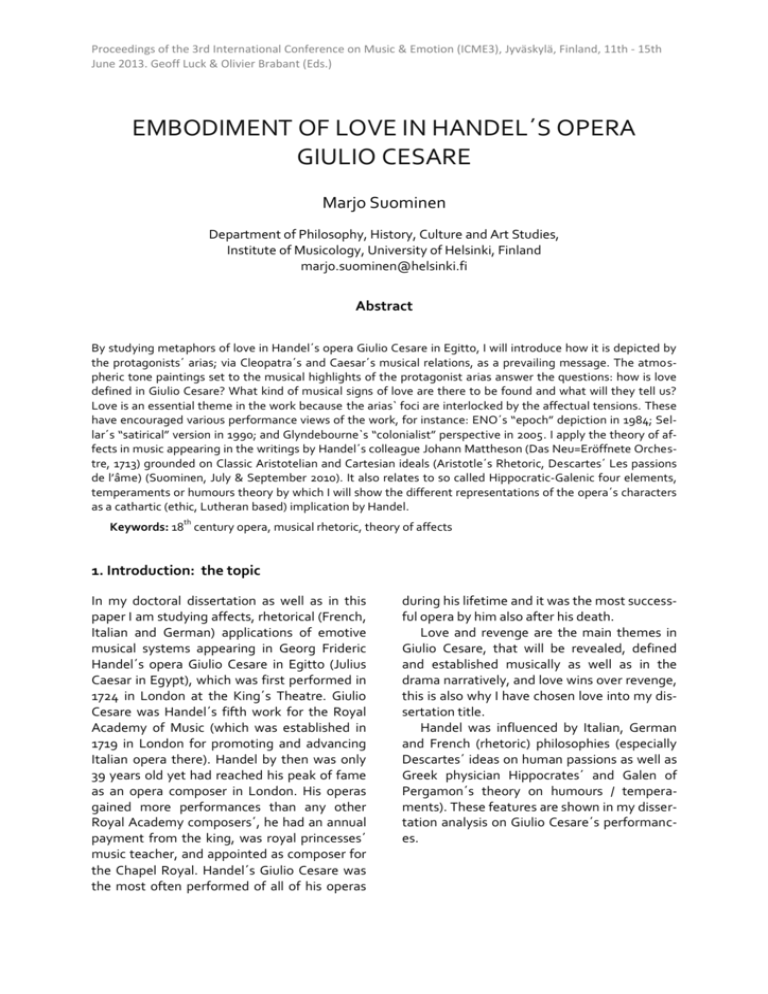
Proceedings of the 3rd International Conference on Music & Emotion (ICME3), Jyväskylä, Finland, 11th - 15th June 2013. Geoff Luck & Olivier Brabant (Eds.) EMBODIMENT OF LOVE IN HANDEL´S OPERA GIULIO CESARE Marjo Suominen Department of Philosophy, History, Culture and Art Studies, Institute of Musicology, University of Helsinki, Finland marjo.suominen@helsinki.fi Abstract By studying metaphors of love in Handel´s opera Giulio Cesare in Egitto, I will introduce how it is depicted by the protagonists´ arias; via Cleopatra´s and Caesar´s musical relations, as a prevailing message. The atmospheric tone paintings set to the musical highlights of the protagonist arias answer the questions: how is love defined in Giulio Cesare? What kind of musical signs of love are there to be found and what will they tell us? Love is an essential theme in the work because the arias` foci are interlocked by the affectual tensions. These have encouraged various performance views of the work, for instance: ENO´s “epoch” depiction in 1984; Sellar´s “satirical” version in 1990; and Glyndebourne`s “colonialist” perspective in 2005. I apply the theory of affects in music appearing in the writings by Handel´s colleague Johann Mattheson (Das Neu=Eröffnete Orchestre, 1713) grounded on Classic Aristotelian and Cartesian ideals (Aristotle´s Rhetoric, Descartes´ es passions de l e) (Suominen, July & September 2010). It also relates to so called Hippocratic-Galenic four elements, temperaments or humours theory by which I will show the different representations of the opera´s characters as a cathartic (ethic, Lutheran based) implication by Handel. th Keywords: 18 century opera, musical rhetoric, theory of affects 1. Introduction: the topic In my doctoral dissertation as well as in this paper I am studying affects, rhetorical (French, Italian and German) applications of emotive musical systems appearing in Georg Frideric Handel´s opera Giulio Cesare in Egitto (Julius Caesar in Egypt), which was first performed in 1724 in London at the King´s Theatre. Giulio Cesare was Handel´s fifth work for the Royal Academy of Music (which was established in 1719 in London for promoting and advancing Italian opera there). Handel by then was only 39 years old yet had reached his peak of fame as an opera composer in London. His operas gained more performances than any other Royal Academy composers´, he had an annual payment from the king, was royal princesses´ music teacher, and appointed as composer for the Chapel Royal. Handel´s Giulio Cesare was the most often performed of all of his operas during his lifetime and it was the most successful opera by him also after his death. Love and revenge are the main themes in Giulio Cesare, that will be revealed, defined and established musically as well as in the drama narratively, and love wins over revenge, this is also why I have chosen love into my dissertation title. Handel was influenced by Italian, German and French (rhetoric) philosophies (especially Descartes´ ideas on human passions as well as Greek physician Hippocrates´ and Galen of Pergamon´s theory on humours / temperaments). These features are shown in my dissertation analysis on Giulio Cesare´s performances. Proceedings of the 3rd International Conference on Music & Emotion (ICME3), Jyväskylä, Finland, 11th - 15th June 2013. Geoff Luck & Olivier Brabant (Eds.) 2. Previous research There has been a vast range of musicological research done by many scholars on Handel and his works in general, for instance by such great names as: Donald Burrows, Terence Best, Suzanne Apsden, Graydon Beeks, Hans Dieter Clausen, Winton Dean, Ellen Harris, Anette Landgraf, Anthony Hicks, Lowell Lindgren, Hans Joachim Marx, Martha Ronish, Ruth Smith, Dorothea Schröder, Steffen Voss et alii. These have been mostly manuscript based studies. Dr. Johanna Ethnersson from the University of Stockholm has published a research article on Giulio Cesare in Svenska Samfundet för Musikforskning. She studied the changing roles of manhood and womanhood of the protagonists via musical analysis by utilizing gender theory as a framework. Dr. Bettina Varwig from the King´s College London has studied rhetorical principles of musical forms and historical modes of analysis and listening in the 17th Century. Professor Dietrich Bartel from Canadian Mennonite University Winnipeg Manitoba pursues research in the area of German Baroque music theory, doctrine of musical-rhetorical figures. His book Musica Poetica (1997) has become as a standard work, a textbook in the field of musical rhetoric. A proceedings article based on my international conferences´ speeches has been published online in internet on December 12th 2011 titled as “Signs and Messages of ove in Performing Handel´s Giulio Cesare”. The article is found from the Sibelius Academy´s proceedings database. During 2013 a peer-reviewed conference proceedings book will be appearing containing also an article by me on this same theme. with an emphasis on a definition of a beauty by Italian rhetoric ways); 2) American stage director Peter Sellar´s modern, politically aware ”satirical” / hunting version fro 1990 (which is an instance of the Ciceronian irony, making ridiculous out of tyranny and stressing effectiveness by French rhetoric means); and 3) Glyndebourne´s festival performance production from 2005, which I have named here as a “colonialist” / ilitary perspective of the work (which is an example of morally universal ideas and ideals giving an emphasis on rationality by German rhetoric views). These three performances are seen as thinking models for later recent interpretations of the opera. 3.1. On the study As already mentioned previously here, I have chosen to study how love is defined in the work. Also, this can be applied to the overall musical structure of the opera, which again, is seen via French, Italian, and German musically defined rhetoric ideals. The Ouverture, which is in A major, is seen as reflecting the affect of impressiveness, and because of this it represents the French typed of musical rhetoric thinking, while the finale starting in Bb major, and basicly in G major, stands for that of grand and brilliant, i.e. joyful affects, within those representing both the Italian and German rhetoric musical ideals (please, see table no. 1: the overall structure of the opera). Table 1. The Overall structure (Handel: Giulio Cesare, 1724): Overture A 3. My research aims Main themes of Giulio Cesare, love and revenge, are interlocked by the affectual tensions in arias. These have encouraged various performance views of the work. I will utilize them as basic instances of the opera: 1) English National Opera´s “epoch” / pastoral depiction from 1984 (which is an example of a brilliant, sublime manner having Finale ( Bb) G (arias) impressive (grand / brilliant) joyful By examining the theatricality (poetic / scenic and musical levels), as seen by the characterization of the personages of the work, I am studying the protagonist and the other characters of the opera via the Hippocratic / Galenic Proceedings of the 3rd International Conference on Music & Emotion (ICME3), Jyväskylä, Finland, 11th - 15th June 2013. Geoff Luck & Olivier Brabant (Eds.) theory of the four (basic) humours / temperaments (sanguine, choleric, melancholic, phlegmatic) and as temperamental / humoural types of heroic and sensual, which is related to rhetoric by its connections with the affect (ie. emotional) tensions (Goltz, 1992). In Handel´s Giulio Cesare, this agential duality is modified as a counter-forcible embodiment of the main theme (of love and vengeance) of the opera, appearing as a positive vengeance (manifested by Caesar) and as negative vengeance (by Ptolemy), as a positive love (by Cleopatra), and as a negative love (by Ptolemy and Achilla). I study the appearance of Cleopatra´s figure in her different roles as a feminine character exchanging with that of Caesar´s masculinity which is questioned as well as seeing Cleopatra turning into a hero instead of merely being a heroine. I study how this has been handled in the three performance instances mentioned already above. (Please, see table no. 2: the roles of the opera). Table 2. Roles of Giulio Cesare Role Voice type Giulio Cesare alto castrato (Julius Caesar) Cleopatra, Queen soprano of Egypt Tolomeo, her alto castrato brother and husband, King of Egypt Cornelia, widow contralto of Pompey Sesto, Cornelia´s soprano (en stepson travesti) Achilla, Tolomeo's Genbass eral Curio, a praetor, bass Caesar's General Nireno, Cleopatalto castrato ra's and Tolomeo's servant Premiere Cast, 20 February 1724 Senesino Francesca Cuzzoni Gaetano Berenstadt Anastasia Robinson Margherita Durastanti Giuseppe Maria Boschi John Lagarde Giuseppe Bigonzi Giulio Cesare is scored for trumpet, 4 horns, 2 oboes, bassoon, flute, first, second and third violins, violas, cello, viola da gamba, harp, theorbo and basso continuo. 3.2. On the object of my analysis Handel was a creator of skillfully set musical moods. He merged traditional German firm contrasting harmonic ideas with ItalianateFrench musical rhetoric usage of affects, which he formulated into his inventive expression. I examine Handel´s rhetoric based affectual musical methods occurring in his Giulio Cesare which function as opera´s alternatives giving hidden narrative clues for different performance views. According to Aristotelian cathartic (soul purifying) ideal, in his Giulio Cesare, Handel puts forward, the quest for a virtuous rulership (Aristotle, 1997 [2012], 17). The opera´s characters have been defined by Platonian, Aristotelian, and Empedoclean atomistic proportions (Parry, 2005) of opposite pairs (Parsons, 2006). The personages can be grouped along classic (geometrical) elements, which were furthered into a medical-psychological theory of humours by Hippocrates-Galen-Avicenna (Goltz, 1992); and Aristotle´s syllogistic square of opposition (Parsons, 2006). This relates to the Aristotelian thesis of substantiating, and finding a way of narrating a story by allowing its listeners to participate in a “true” argu ent (Aristotle, 1997 [2012]). 4. On the performance analysis of the opera Handel applies the square of opposition in Giulio Cesare, and though being an opera seria, it contains ironical elements. Handel contradicts tragedy and irony, developing his own type of a Machiavellian “choise” for dra a. Other opposed elements in Giulio Cesare are the characters, the main themes: love and revenge. Through love, Caesar and Cleopatra will succeed in getting the power, to rule over Egypt, and Rome together equitably and defeating the obvious tyrant, the rival Ptolemy, deemed unsuited to reign. Handel followed Cicero by his allegorical and metaphorical creations, by having formed out highpoints of resemblances to natural phenomena in his metaphoric simile (or Devisen) arias. Handel utilizes in his Giulio Cesare some basic and best known rhetorical concepts of his Proceedings of the 3rd International Conference on Music & Emotion (ICME3), Jyväskylä, Finland, 11th - 15th June 2013. Geoff Luck & Olivier Brabant (Eds.) time such as for instance a) metaphors (which are i plied co parisons without “like” or “as”; for example this is shown in practice in Cleopatra´s aria “Tu la ia stella sei”, in act I, scene 2; in which Cleopatra compares Caesar to a star who shows and stands for her the right path both to joys of love and righteous rulership, emphasizing the affect of love); b) similes (which are comparisons using “like” or “as”; for exa ple in Caesar´s aria “Va tacito e nascosto” in act I, scene 3; here a clever and righteous ruler is being compared to a skilled huntsman in representing the affect of a positive revenge by Caesar towards Ptolemy´s tyrannical acts (Aristotle, 1997 [2012], Rhetoric III ch.4, 123-4); (verbal) c) irony (which is saying one thing and meaning the opposite; for exa ple Cleopatra in her aria “Non disperar”, in act I, scene 2; her scornful ideas towards her brother Ptolemy who is having a joint tenancy with her are being disguised here as benevolent wishes, here she has the affects of joy and contempt; see René Descartes about Mockery in his Passions of the Soul, 1649: Derision or Mockery is a species of Joy mingled with Hatred which arises from perceiving some small misfortune in a person we think to be deserving of it. We have Hatred for this misfortune, and Joy in seeing it in someone who deserves it. And when it springs up unexpectedly, the surprise of Wonder causes us to break into laughter - (Descartes, 1649 [1989] art. 178, 117). Also Thomas Hobbes describes mockery calling it as a sudden glory in his Leviathan (1651), for Plato laughter represented scorn (= mockery; Hobbes, 1651 [2012]) and Aristotle agreed with him having added to that the description of youth, which is applicable Handel´s portrayal of the young impatient and fierynatured Cleopatra in his Giulio Cesare (Aristotle, 1997 [2012], Rhetoric II ch.12, 85-6). Yet another rhetorical concept is that of: d) juxtaposition (i.e. an antithesis, which is a rhetorical scheme meaning “placing side by side” of two elements for contrast and emphasis; in Cleopatra´s aria “Piangerò la sorte ia” in act III, scene 1; the affects of grief and revenge have been placed side by side for to emphasize her right for revenge (= a positive revenge). (Aristotle 1997 [2012], Rhetoric III ch. 9, 20; 132). 4.1. On recent performance instances I have chosen for my analysis here three performance versions, which to my mind will give some variable (opposing) views and choices on the musical affectual depictions found from the opera. The English National Opera´s traditional “epoch” / pastoral perspective fro 1984, gives a particular overview on the changes of the work. The other versions sung in their original language in Italian have various emphasis based on their overall productions according to which I have titled the as “satirical / hunting, the Peter Sellar´s version fro 1990, and “colonialist” / ilitary, the Glyndebourne performance from 2005. Caesar´s state of mind starts from his victorious mood which will be introduced in his opening aria, towards more justified revenge (a positive act), via his longing for love to consolidation of alliance between the two states, Rome and Egypt and constancy of his love towards Cleopatra (loyalty), set by him as the ruler of Egypt. Cleopatra begins by a joyful expectation wishing for good prospects (an act of innocence). By awaking love, she hopes to cast herself into power and as the sole holder of the throne. She will achieve her goal by dubious seduction (an act of a negative love), but her emotions and motives will be cleared and revealed by her true affects of despair, lamenting and victorious revengefulness (acts of catharsis) over Caesar´s enemies, and finally by her fairness through her love (an act of positive love) towards Caesar and justice. Beauty is being celebrated here as a morally virtuous act (a realization of justice, righteousness). 4.2. Protagonist roles Both the musical key relations and time signatures of Caesar´s and Cleopatra´s arias suggest that there is an antithesis of characters set by Handel. Cleopatra starts with the key of fate and love (in E major) and pilots the way for Caesar´s emotional side which is hidden at first by his acts of bravery (in C major) which in the end prove to be also acts of true and righteous love. Proceedings of the 3rd International Conference on Music & Emotion (ICME3), Jyväskylä, Finland, 11th - 15th June 2013. Geoff Luck & Olivier Brabant (Eds.) On the other hand, Cleopatra hides her real thirst-for-power motives under her disguise of love, and pastoral charm attempts, so nothing is foretold in the beginning of the opera although the ideals have already been introduced by Handel at the beginning of the work. In his aria “Presti o ai” he is already being proudly self-assertive, inviting the people to receive and accept him as a victor. His musical affect is heroic, in an Allegro-duple meter, in D major key. Onwards moving harmony is connected with accentuated melodic line, which alternates between larger leaps, intervals and a stepwise progression containing with coloratura fragments. Already in the third scene of the first act, Caesar performs his second aria, which depicts his second important character type: the warrior. Since the beginning, he is introduced as a high-ranking person within the hierarchy of the characters. He is triumphant, victorious and militant character type, which status continues to be confirmed both by textual and musical means the course of the opera. His flawlessness and masculinity are being emphasized directly and indirectly. In a monologue “Al a del gran Po peo” he reflects a brave hero´s fragile lifespan. Here the accompanied recitative instead of an aria stresses that this is a reflection, contemplation. The music functions as a support, clarifying the text as declamatory forth bringing force by heavily and dark accented strokes of strings. The hero´s noble position will be strengthened by the opening´s majestic Largo, in which the French overture´s tone is prevailing with the dotted Sarabande figures. Modulating harmony attests his pondering and searching state of a mind. One can sense how the moods of the protagonists proceed from aspiring to certainty by Cleopatra and assuring reliability of Caesar´s faculties to reign and to effect on Cleopatra. (Ethnersson, 2005). 5. Comparing the performances By Sellar´s (1990) Cleopatra´s pastoral innocence is questioned right from the start, as she is depicted as a girl, who is used to luxury, and both she and her brother Ptolemy show a shallow side of themselves by being fond of com- modities offered by the superpower, which in turn is represented by Caesar, also parodied here, by his exaggerated need for protection and surveillance. ENO´s production gives wittier character to Cleopatra, to whom her brother does not give much of a competition, so it is obvious that she possesses those special abilities required from a ruler. Caesar´s role is also stabilized by ENO´s production as he seems to be mostly equal to his position. Glyndebourne´s version is shadowed by warlike efforts, the sets are decorated by fleets and zeppelins in the background, yet the overall mood is positive and mellow, almost musical-styled with athletic gestured dance scenes. Cleopatra is shown as a real queen with “Egyptionized” choreographies including symbols of ancient Egyptian deities of the royal powers, which refer to her historical Greek (Ptolemaic) origins, and to her aims for having tried to please her subjects by maintaining the traditions despite of the new winds blowing from Caesar´s direction, Rome. Sellar´s view on baroque dance forms occurs as a satirical tool for his palette of sharp typed of ballet gestures in a French manner by which the overture of the opera is also written. Handel´s perfor ance direction of “ ajestic” will be questioned, as are all actions into gaining exclusive power, opposing to that of an autocrat. ENO´s reply to that is choosing the legitimate alliance of two rulers. While Glyndebourne´s route is gaining sovereignty by agreeing on peace and by the importance of emphasizing signing the peace treaty. Which one of these might be Handel´s choice in the end, one could play with this thought for a fleeting moment, but then again he has left choices open for the performers to close, solve or unfold. The main theme of the opera which is love is being celebrated and highlighted in the end of the work, in the finale. Love is peace in Giulio Cesare by Handel, which proves to make out of him one among pacifists of his time. So probably the ultimate message of the work is as follows: “let there be peace on earth for all people”. Proceedings of the 3rd International Conference on Music & Emotion (ICME3), Jyväskylä, Finland, 11th - 15th June 2013. Geoff Luck & Olivier Brabant (Eds.) References Aquila, Rafael del (2001). “Machiavelli s Theory of Political Action: Tragedy, Irony and Choice”. EUI Working Paper SPS No. 2001/3. European University Institute, Florence, Department of Political and Social Sciences. Retrieved May 30 2011 from http://cadmus.eui.eu/bitstream/handle/1814/316/sp s20013 Aristoteles (Aristotle; 1997 [2012]). Retoriikka (Rhetoric). Runousoppi (Poetics). Translated into Finnish by Paavo Hohti, annotations by Juha Sihvola. Tampere: Gaudeamus. Bartel, Dietrich (1997). Musica Poetica Musical Rhetorical Figure in German Baroque Music. Lincoln & London: University of Nebraska Press. Buelow, George J. (1983). Johann Mattheson and the invention of the Affektenlehre, [in:] New Mattheson Studies,George Buelow & Hans Joachim Marx (ed.), Cambridge, New York: Cambridge University Press, 393-408. Burrows, Donald (1994). Handel. Stanley Sadie (ed.), Oxford: Oxford University Press. Cicero, Marcus Tullius (2006). Puhujasta (De Oratore / On the Orator), translated into Finnish by Aulikki Vuola, Helsinki: Gaudeamus. Christensen, Otto M. (1995). Interpretation and Meaning in Music, [in:] Musical Signification, Essays in the Semiotic Theory and Analysis of Music, Eero Tarasti (ed.),New York-Berlin: Mouton de Gruyter, 81-91. Dean, Winton (1969 [1970]). Handel and the Opera seria, University of California Press, California & London: University of California Press. Descartes, René (1649). Les Passions de l’âme, Paris. Ethnersson, Johanna (2005). Opera seria och musikalisk representation av genus, [in:] STM-Online 8/2005. Retrieved January 28, 2011 from http://www.musikforskning.se/stmonline/vol_8/eth nersson/index.php?menu=3. Frede, Dorothea (2003 [2009]). Plato s Ethics: An Overview. Virtues of State and Soul, SEP, Stanford Encyclopedia of Philosophy 9/2003& 5/2009. Retrieved February 2, 2011 from http://plato.stanford.edu/entries/platoethics/#VirSt aSou. Goltz, D. (1992). “Säfte, Säftelehre”. Historisches Wörterbuch der Philosophie, Band 8, Joachim Ritter & Karlfried Gründer (ed.), Schwabe & Co, Basel & Darmstadt: Wissenschaftliche Buchgesellschaft. Helm, Bennett (2005 [2009]). Love, [in:] Stanford Encyclopedia of Philosophy Apr 8, 2005, rev. Jul 9, 2009. Retrieved May 7, 2010 from http://plato.standford.edu/entries/love. Hicks, Anthony (2007). Giulio Cesare in Egitto (ii), [in:] Oxford Music Online, 2007. Retrieved June 10 2010 from http://www.oxfordmusiconline.com /subscriber/article/grove/music/O004424?q=Giulio+ Cesare+in+Egitto&search=quick&pos=2&_start=1# firsthit. Hobbes, Thomas (1651 [2012]). Leviathan. Ebooks@Adelaide The University of Adelaide. Rendered into HTML by Steve Thomas. Last updated September 16, 2012. Retrieved Feb. 15th 2013 from http://ebooks.adelaide.edu.au/h/hobbes /thomas /h68l/index.html. Kutzer, M. (1998). Temperament, [in:] Historisches Wörterbuch der Philosophie, Band 10, Joachim Ritter & Karlfried Gründer (ed.), Schwabe & Co, Basel & Darmstadt: Wissenschaftliche Buchgesellschaft. Lang, Paul Henry (1967). The Enlightenment and Music, [in:] Eighteenth-Century Studies, Vol. 1, No. 1, Autumn, The Johns Hopkins University Press, 93-108. Landon, Robbins H. C. (1979). Studies in Eighteenth-Century Music. A Tribute to Karl Geiringer on His Seventieth Birthday, New York: Da Capo Press . Mattheson, Johann (2002 [2007]). Das Neu=Eröffnete Orchester. Reprint der Ausgabe Hamburg 1713. Magdeburg: Laaber. Marx, Hans Joachim (2002). Händel, Hendel, Handel, Georg Friedrich, Giorgio Federico, Georg Frideric, [in:] Die Musik in Geschichte und Gegenwart, Allgemeine Enzyklopädie der Musik begründet von Friedrich Blume, Personenteil 8 (Gri-Hil), 2nd edition, Ludwig Finscher (ed.), Kassel: Bärenreiter, 509-638. Moseley, Alexander (2001 [2005]). Philosophy of Love, [in:] Internet Encyclopedia of Philosophy, IEP April /17/2001 updated June 29, 2005. Retrieved May 7, 2010 from http://www.iep.utm.edu/love/. Parry, Richard, Empedocles (2005). [In:] Stanford Encyclopedia of Philosophy (SEP), 2005. Retrieved May 3, 2011 from http://plato.stanford.edu/entries/empedocles/. Parsons, Terence (2006). The Traditional Square of Opposition, [in:] Stanford Encyclopedia of Philosophy (SEP), 2006. Retrieved May 3, 2011 from http://plato.stanford.edu/entries/square/. Sartwell, Crispin, Beauty (2012). [In:] Internet Encyclopedia of Philosophy, IEP, 2012 Sept 4, 2012, ed. by Edward N. Zalta. Retrieved January 26 th, Proceedings of the 3rd International Conference on Music & Emotion (ICME3), Jyväskylä, Finland, 11th - 15th June 2013. Geoff Luck & Olivier Brabant (Eds.) 2012 from /beauty/. http://plato.stanford.edu/entries Schleifer, Ronald (1987). A.J. Greimas and the nature of meaning, linguistics, semiotics, and discourse theory, Lincoln:University of Nebraska Press, 100-23. Spitzer, Michael (2004). Metaphor and Musical Thought. Chicago and London: The University of Chicago. Suominen, Marjo (2010). Signs and Messages of Love in Handel’s Giulio Cesare. A paper presented at the 14th Biennial International Conference on Baroque Music, Queen s University, School of Music and Sonic Arts, Belfast, Northern Ireland, July 1st 2010. (2010). Signs and Messages of Love in performing Handel s Giulio Cesare. A paper presented at the international conference Embodiment of Authority: Perspectives on Performances Conference, Helsinki, Finland, September 11th 2010. (2010), Signs and Messages of ove in Handel s. A paper presented at the ICMS, 11th International Congress on Musical Signification, Academy of music in Krakow, Poland, September 30th 2010. (2011) Signs and Messages of Love in performing Handel´s Giulio Cesare, an online proceedings article of The international conference on The Embodiment of Authority: http://www.siba.fi/web/embodimentofauthority /proceedings/suominen Tarasti, Eero (2002). Signs of Music, A Guide to Musical Semiotics, Berlin & New York: Mouton de Gruyter. Video recordings: Julius Caesar (1984 [1979]). D: John Copley (live performance in 1979) / John Michael Phillips (video in 1984). M: G. F. Händel. Mr: English National Opera Orchestra by musical direction of Sir Charles Mackerras. C: Michael Stennett. S: John Pascoe. A/S: James Bowman – Ptolemy, Valerie Masterson – Cleopatra, Sarah Walker – Cor nelia, Della Jones – Sextus, John Tomlinson – Achillas. P: HBO / Pioneer. L: c. 180 min. An abbreviated version of the opera, which is sung in English, and translated into English by: Brian Trowell. Giulio Cesare (1990). D: Peter Sellars. M: G. F. Händel. Mr: Dresden Sachsische Staatskapelle by musical direction of Craig Smith. A/S: Jeffrey Gall – Caesar, Susan Larson – Cleopatra, Drew Minter – Ptolemaios, Mary Westerbrook-Geha – Cornelia, Lorraine Hunt – Sexus, James Maddalena – Achillas. P: Decca: VHS PAL 071 408-3, LD 071 408-1. L: c. 150 min. Sung by the original language, in Italian. (Archival source: I.R.T.E.M, Instituto di ricercare per il teatro musicale, Rome). Giulio Cesare in Egitto (2005). D: David McVicar. M: G. F. Händel. Mr: The Glyndebourne Chorus directed by Bernard McDonald, and The Orchestra of the Age of Enlightenment by the musical direction of William Christie. A/S: Sarah Connolly – Cesare, Danielle de Neise - Cleopatra, Angelika Kirchschlager - Sesto, Christophe Dumaux – Tolomeo, Patricia Bardon – Cornelia, Christopher Maltman - Achille, Alexander Ashworth - Curio, Rachid ben Abdeslam – Nireno. C: Brigitte Reffenstuel. P: A Glyndebourne/Opus Arte co-production, recorded live at the Glyndebourne Opera House, Lewes, East Sussex, United Kingdom on 14 & 17 August 2005. L: 305min. Sung in Italian with English, French, German, Spanish, and Italian subtitles. (Abbreviations: D = Scenic direction, M: music, Mr: musical realization/performers, S =Staging/sets, C = costume design, A/S = actors/ soloists, P =publication, L= length).

